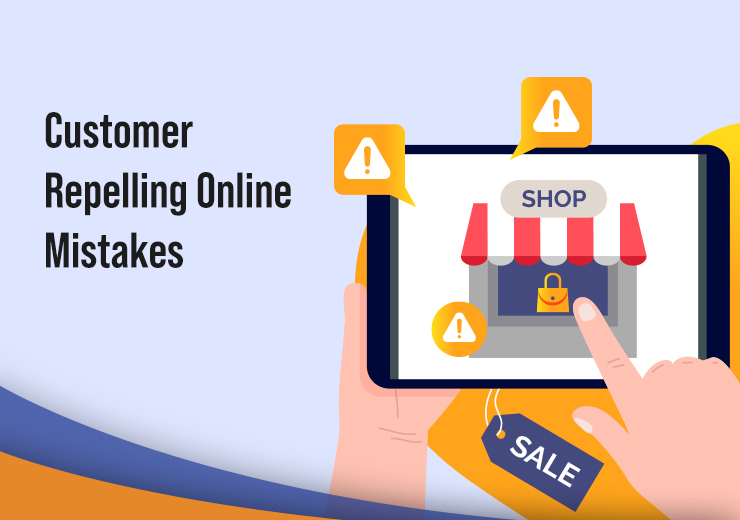
Consumers are increasingly shopping on their mobile phones; now more than ever, it has become necessary for eCommerce sites to have a responsive design for mobiles! In a study of 105 retailers by Digital Commerce 360 (2020), 46% of retailers outlined the importance of mobile-responsive eCommerce sites as a ‘must-have’ feature in improving conversion rates. Mobile-responsive features typically entail resized text, navigation, fewer product images, and layout.
Creating A Mobile-responsive eCommerce Site
To develop an eCommerce store that is mobile responsive, you must consider some essential factors to create a seamless user experience.
1. Adhering to the Current UX/Ui Standards
A simple and appealing interface can make a huge difference in user response to your website. Some components to look into while creating your mobile eCommerce site include:
- Size of the hands
- Readability
- Background
- Haptic feature
- Spacing
Pro tip: Offering users additional features such as ‘Dark Mode’ will become a great bonus to enhance customers’ browsing experience.
2. Navigation with Thumb
Customers enjoy a comfortable navigation experience while shopping. In fact, as a mobile-responsive website, one of its most crucial design features is that you can navigate it simply by using your index finger or thumb. When this isn’t ensured, the users need to pinch to zoom the content. It means either the content looks too small on their screen or isn’t optimized for mobile devices. It will naturally lead to more and more touch errors.
Studies have suggested that as the average width of a human index finger ranges from 1.6 to 2 cm for adults, it converts to 45 – 56 pixels. Following this measurement will let the buyer’s finger fit nicely in the target. The thumbs can go up to 70 – 72 pixels. In addition, pay attention to your website layout, spacing, and scrolling elements on your mobile site.
Pro tip: Keeping a measurement of around 50 to 70 pixels would make a site navigable and easy to use.
3. Visible Placement of Call-To-Action (CTA)
Call-to-action buttons are crucial to boost user engagement and generate sales. The ‘Add-to-cart’ button must stand out. In most cases, the CTAs are placed right above the fold, i.e., front and center. Studies have shown that placing CTAs below the fold can also result in more excellent conversion rates. There are three things that you need to note in this regard:
Pre-sold buyers who already want your products when they come: In this case, the specifics of your products are not relevant. Give your prospects a CTA right away to have that momentum going.
Uncertain buyers need an offering whose value can be immediately understood: These potential buyers are unsure. They need a bit of blatant, strong copy that convinces them to respond to the CTA. As too much copy isn’t necessary, you can place the CTA higher on your page – even above the fold.
Uncertain buyers and a product that needs some explanation for value assessment: These potential buyers will require a substantial copy that’s not just clear but is also well-written to hold their interest right from the headline to the CTA. Now, how much copy is required depends on how much the prospect knows already, how complex the offering is, the cost, and the likes. So, you can keep it at 500 words or take it to 5,000 words – you will be the judge of that.
Pro tip: Assess the target audience of the content you are uploading and decide where you want to place the CTA.
4. Guest Cart Checkout Option
Allowing your potential customers to checkout as guests will encourage them to return to the app whenever they have time. Customers do not want to sign up on a site every time they return immediately. Giving them an option to choose guest checkout will help you reduce cart abandonment.
Additionally, the conversion rates for guest checkout are always higher than complete sign-in because the customers want more than just getting to complete the process faster. When it’s their first time at a site, they might feel insecure about entering personal details or sensitive information.
So, let them come back as guests time and again for your products and services. Your site, your offerings, and your content would make them sign up and become loyal customers eventually.
Pro tip: Consolidate the entire checkout process in a single page to simplify things even further for customers. Multiple pages take more time to load and confuse the buyer.
5. Custom Search Using the Audio Search
Customers enjoy the most user-friendly version of their favorite websites. If you provide an option for audio search, customers will be delighted to use this option for convenience. This unique function has not yet been implemented across all your competitors, so stay one step ahead and use the latest technological features on your site.
Pro tip: When enabling audio search, use the keywords accordingly. “Dog food under 500” should land on your products, but “what does a Labrador eat?” would land on your eCommerce blog page.
6. Screen Size
Although you may have created a site for mobile phones, it is also essential that your site performs well across various telephones. Screen size is the diagonal measurement of physical displays. You can use the RWD approach to enable responsiveness by altering information, graphics, and symbols by percentages of the screen size. Screen size plays a vital role in making your eCommerce site mobile-responsive.
Pro tip: Focus on creating adaptive layouts for the most common screen widths, i.e., 1600px, 1200px, 960px, 760px, 480px, and 320px.
7. Website Speed
You should continually test the performance and speed of your website on your phone. For example, if a site takes longer than 3 seconds to load, 53% of mobile customers will leave.
Also, your rank on the search engines and your conversion rates are closely linked. You need to be on the first page of Google for more people to visit your site. When you improve your page speed, your website ranking improves in tandem. Thus, you get more potential customers on your site.
You can begin with tools such as ‘Google Page Speed Insights’ and ‘Core Web Vitals’ to test your website speed.
Pro tip: If you want a free tool to run a thorough performance test on the site, you can try Google Pagespeed Insights, which offers suggestions to improve performance.
8. Progressive Web Application (PWA)
Progressive web applications are responsive web applications created specifically for mobile devices. They have a quick-release time, bridge the communication gap between you and customers, and enhance your site’s performance.
Think of them as a fusion of the best features of mobile apps and web pages. They come with several benefits like:
- smaller size
- shorter loading time
- instant updates
- integrated analytics
- performing well even in a poor network situation
- avoiding app aggregators (App Store, Google Play)
app-like functions (push notifications, offline mode, adding to home screen)
When mobile user behavior is so demanding, downloading and using a PWA is as easy as ever. Besides, as you can see from the points mentioned above, it does all that is needed to boost conversion rates. Integrated analytics also make it easier for you to assess the performance of your eCommerce site.
Pro tip: Integrate the preferred social networks of your customers to enhance the engagement rate and acquisition of the Progressive Web Apps.
9. Avoid Stuffing Your Site with Pop-up Ads
While it may be tempting to add as many pop-up ads on your site as possible, avoid this! They are entirely intrusive and disrupt the user experience. In the short term, you may gain a few clicks and money through your ads, but in the longer run, you will lose potential customers. Besides, using too many will hide the content you have worked so hard to create and upload.
Pro tip: If you have to use pop-ups, at least base them on real-time user behavior to make them more effective in driving conversions. So, if the user is watching a video, suggest something closely related to that video, and put the pop-up towards the end of the video.
10. Eliminate Unnecessary Features
Finally, for your online store development on mobile phones, you must review the overall site to assess its features, usability, etc. In this process, eliminate all items that are not essential and can hamper a smoother user experience. From sidebars to pop-ups and lengthy content, review and make the necessary cuts to ensure your mobile site is slick.
Pro tip: Apart from removing unwanted features, use text links that do not affect the scrolling experience but reveal the field when they are clicked on.
The Bottom Line
Thus, embarking on creating a mobile-responsive eCommerce site can be daunting. Yet, considering the factors mentioned in this article, you can add value to your planning process. Once you strategize by including these factors, your implementation process will become easier. You will see the results in better conversion rates within a few days.
Vserve has a proven track record of seamlessly helping our clients through this transition. Helping them achieve their goals and sales, our team can help you create a profitable mobile responsive eCommerce site. Your eStore will benefit from swiftly reaching your world’s target audience, from smartphones to laptops and tablets. Call us to get your mobile-responsive eCommerce site built within two weeks.








